Conservation status DOM Scientific name Equus caballus Higher classification Horse | Other names Shetland Origin Scotland Rank Breed | |
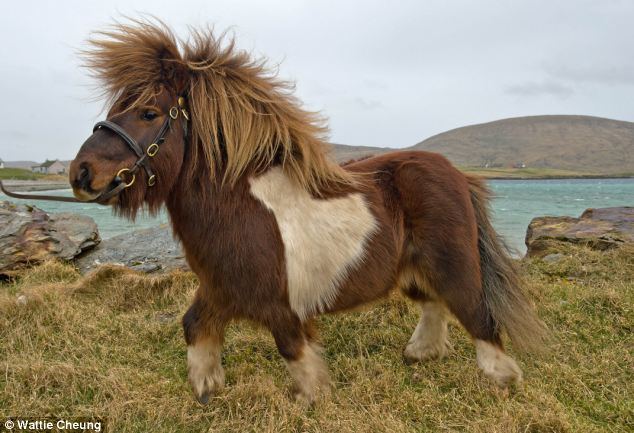 | ||
Country of origin Shetland Islands, United Kingdom Distinguishing features Intelligent, small size, sturdy build, thick coat, compact and strong. American subtype more refined with longer legs and finer coat Similar Falabella, Icelandic horse, Fjord horse, Haflinger, Appaloosa | ||
The Shetland pony is a breed of pony originating in the Shetland Isles. Shetlands range in size from a minimum height of approximately 28 inches (7.0 hands; 71 cm) to an official maximum height of 42 inches Registered stock must not exceed 42 inches (107 cm) 10.2 hands (42 inches, 107 cm) at the withers. Shetland ponies have heavy coats, short legs and are considered quite intelligent. They are a very strong breed of pony, used for riding, driving, and pack purposes.
Contents
- Shetland pony race
- History
- Uses
- Characteristics
- The American Shetland
- Standards in the USA and the UK
- References
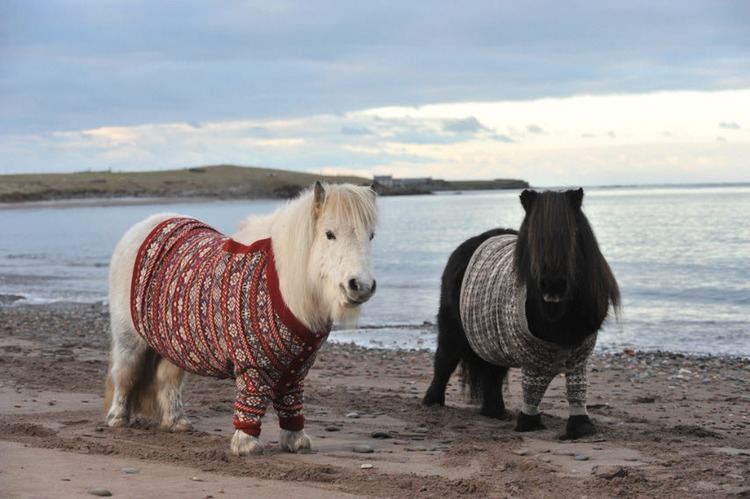
Shetland pony race
History

Shetland ponies originated in the Shetland Isles, located northeast of mainland Scotland. Small horses have been kept on the Shetland Isles since the Bronze Age. People who lived on the islands probably later crossed the native stock with ponies imported by Norse settlers. Shetland ponies also were probably influenced by the Celtic Pony, brought to the islands by settlers between 2000 and 1000 BCE. The harsh climate and scarce food developed the ponies into extremely hardy animals.

Shetland ponies were first used for pulling carts, carrying peat, coal and other items, and plowing farm land. Then, as the Industrial Revolution increased the need for coal in the mid-19th century, thousands of Shetland ponies traveled to mainland Britain to be pit ponies, working underground hauling coal, often for their entire (often short) lives. Coal mines in the eastern United States also imported some of these animals. The last pony mine in the United States closed in 1971.
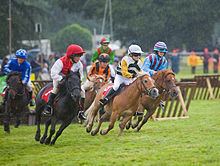
The Shetland Pony Stud-Book Society of the United Kingdom was started in 1890 to maintain purity and encourage high-quality animals. In 1957, the Shetland Islands Premium Stallion Scheme was formed to subsidize high-quality registered stallions to improve the breeding stock.
Uses
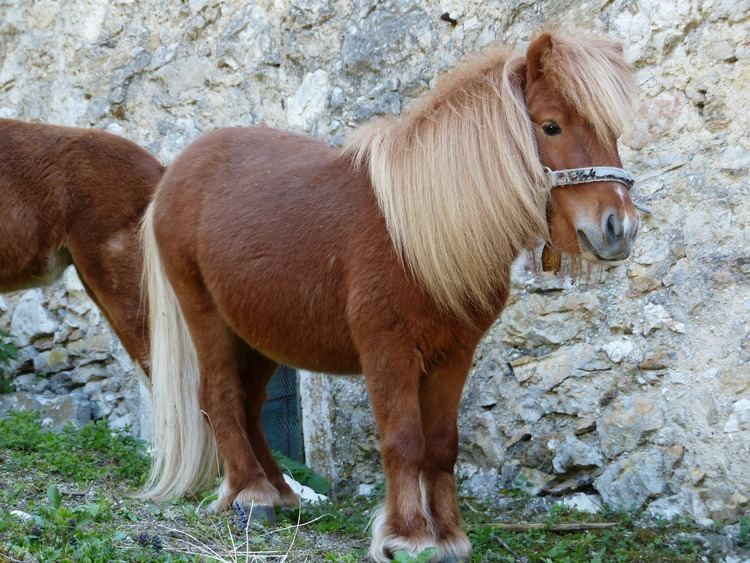
Today, Shetlands are ridden by children and are shown by both children and adults at horse shows in harness driving classes as well as for pleasure driving outside of the show ring. Shetlands are ridden by small children at horse shows, in riding schools and for pleasure. They are seen working in commercial settings such as fairs or carnivals to provide short rides for visitors. They are also seen at petting zoos and sometimes are used for therapeutic horseback riding purposes. In the United Kingdom, Shetlands are also featured in the Shetland Pony Grand National, galloping around a racecourse with young jockeys.
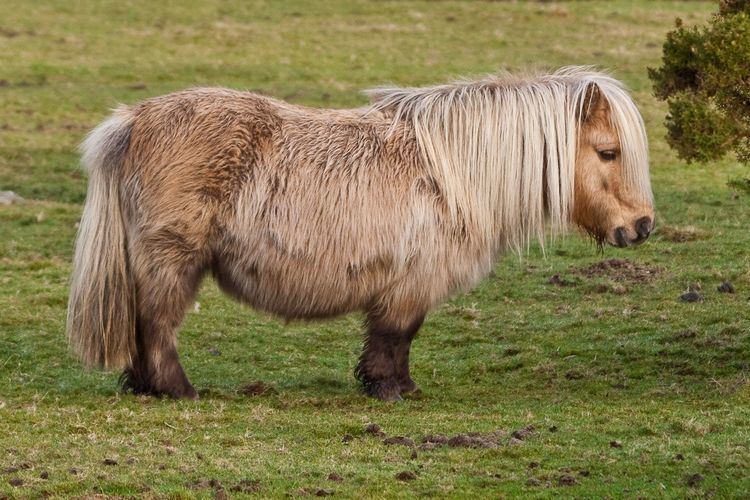
Junior Harness Racing was founded in Queensland by a group of breeders to give young people aged 6–16 an opportunity to obtain a practical introduction to the harness racing industry. The children have the opportunity to drive Shetland ponies in harness under race conditions. No prize money is payable on pony races, although winners and place-getters receive medallions.
Miniature Shetlands have been trained as guide horses to take the same role as guide dogs. This task is also performed by other miniature horse breeds.
The Royal Regiment of Scotland and the Argyll and Sutherland Highlanders, prior to the regiment's formation, adopted the Shetland as its regimental mascot and names them Cruachan.
Characteristics
Shetland Ponies are hardy and strong, in part because the breed developed in the harsh conditions of the Shetland Isles. In appearance, Shetlands have small heads, sometimes with dished faces, widely spaced eyes and small and alert ears. The original breed has a short, muscular neck; a compact, stocky body; short, strong legs; and a shorter-than-normal cannon bone in relation to its size. A short broad back and deep girth are universal characteristics, as is a springy stride. Shetlands have long thick manes and tails and dense double winter coats to withstand harsh weather. Different breed registries have different height standards, but the outside ranges are between 7 and 11.2 hands (28 and 46 inches, 71 and 117 cm)
Shetlands can be almost every colour, including skewbald and piebald (called pinto in the United States), but are mainly black, chestnut, bay, grey, palomino, dun, roan, cremello, and silver dapple. Registered shetlands are not leopard spotted (Appaloosa), nor do they carry the champagne gene, though these colours are sometimes seen in Shetland-sized crossbreds.
Shetland ponies are generally gentle, good-tempered, and very intelligent by nature. They make good children's ponies, and are sometimes noted for having a "brave" character. They can be very opinionated or "cheeky", and can be impatient, snappy, and sometimes become uncooperative. Due in part to their intelligence and size, they are easily spoiled and can be very headstrong if not well-trained.
For its size, the Shetland is the strongest of all horse and pony breeds. It can pull twice its own weight under circumstances where a draft horse can only pull approximately half its own weight, as well as many being able to carry up to 9 stone – 130 pounds (59 kg). Shetland ponies are found worldwide, though mainly in the UK and North America. In general, UK ponies tend to preserve more of the original characteristics of the breed and are often stockier than their American cousins.
Many ponies are long-lived; it is not unusual for a Shetland pony to live more than 30 years. Conversely, their small size also predisposes some individuals to a greater probability of heart problems than in larger animals, on occasion leading to early death. Shetland ponies, like many hardy small horse and pony breeds, can easily develop laminitis if on a diet high in non-structural carbohydrates. Therefore, owners must pay careful attention to nutrition, being careful to regulate feed quantity and type.
The American Shetland
The first Shetland ponies for which there are written records were imported to the United States in 1885 by Eli Elliot. These ponies provided the foundation stock for the development of the American Shetland, and were crossed with ponies of other breeds, including the Hackney pony, Welsh pony, and Harness Show Pony. The breeding of the ponies was mainly centered in Indiana, Illinois and Iowa.
In 1888, the American Shetland Pony Club was formed and now has two studbooks: Division A and Division B. Division A registers ponies with 12.5% or less outcross (non-Shetland) blood, and Division B is open to any pony with 12.5% or more outcross blood. Foundation Certification is also available for ponies from 4 generations of Division A breeding. As of 2009 A and B designations are no longer on Registrations.
American Shetland Ponies are more refined than the traditional Shetland. They often have a long, thin, "hooky" neck, a more refined body, and longer legs. The breed tends to be long and narrow through the back, with broad and muscular hindquarters and high withers. The shoulder has good slope, allowing for extravagant action. These ponies are most often used for harness work and as children's ponies. They can be seen show jumping in classes for young riders, at horse shows in both Western and English riding classes, as well as many other competitive events, including gymkhana, novelty harness racing, and shown at halter, Costume.
The American Shetland Pony Club recognizes four types of Shetlands-Modern, Pleasure, Classic and Foundation. Modern Shetland are typically the tallest of the breed; they are shown with a high head set, ribbon braids in their manes, tail sets and have high stepping action. Pleasure ponies have similar breeding though their action is more subdued. Classic Shetlands are the most typical type and are known for their refinement and gentle nature while lacking most of the action of the Modern ponies. Finally, Foundation ponies do not have any Hackney influence for four generations and are all under 42" tall. Their looks are most reflective of their British ancestry.
However, the compact "classic" type of Shetland is still more prevalent in overall numbers in the USA, though such ponies are not always registered.
German Classic Pony
In 1965, German breeders began to selectively breed American Shetlands to create a "Sporty Shetland Pony." with a more elegant appearance, refined head, friendly look, better gaits, and better temperament. In 2000, when the British Shetland registry refused to register ponies with American bloodlines as purebred, the German breeders formed their own registry, with the breed's official name being the "Deutsches Classic-Pony." All coat colors are acceptable, but liver chestnut with a flaxen mane is particularly common and popular.
Standards in the USA and the UK
There are several major registries for Shetland ponies, the Shetland Pony Stud-Book Society (SPSBS) based in UK, American Shetland Pony Club (ASPC), and the Shetland Pony Society of North America (SPSNA), both based in the USA. Shetland ponies registered with the SPSBS cannot be taller than 42 inches (10.2 hands; 110 cm) at maturity. ASPC Shetlands range in height from about 30 inches (76 cm) (rare) to 46 inches (120 cm) (the ASPC measures in inches, not in hands). The Shetland Pony Society of North America was formed to honor the traditional Shetland Pony of island type. Any pony registered with other American, British, or Canadian registries can be cross-registered if it meets the pedigree and conformation standards of the SPSNA.
